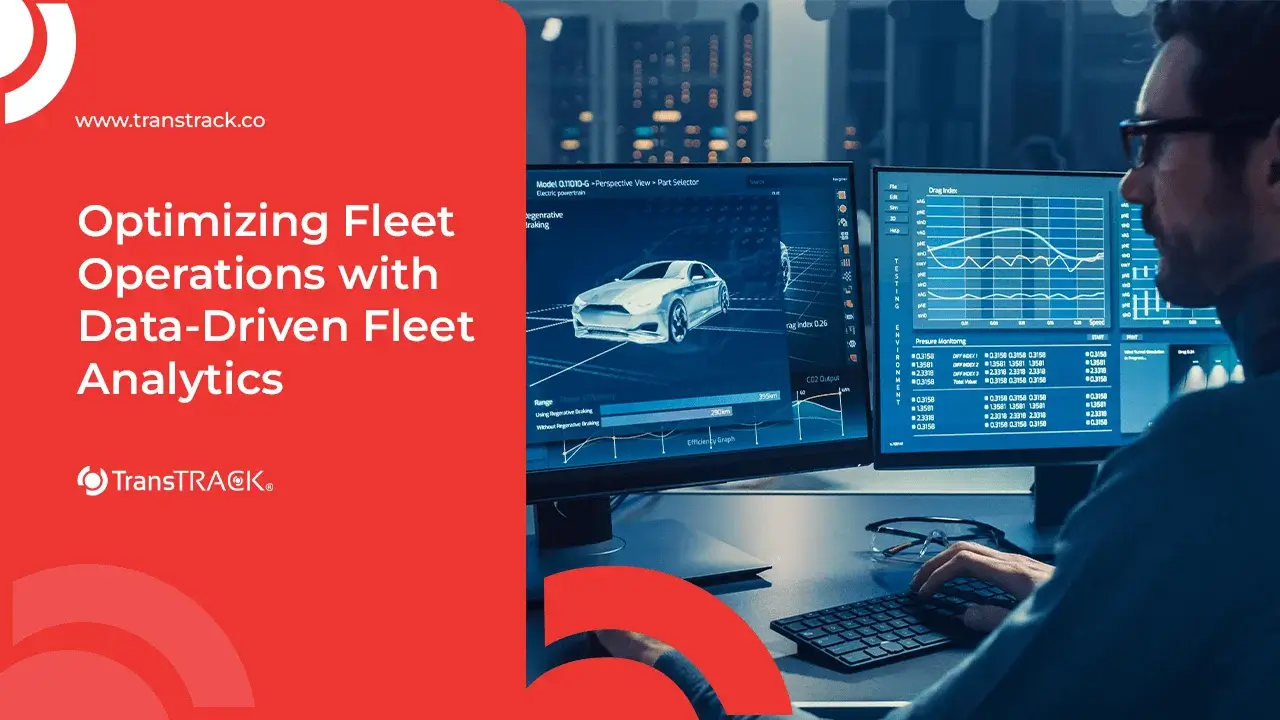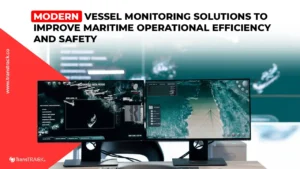Optimizing Fleet Operations with Data-Driven Fleet Analytics
Posted on June 27, 2025 by Nur Wachda Mihmidati

In an increasingly complex and competitive logistics and transportation industry, the ability to manage fleets efficiently is key to operational success. Amid challenges such as high fuel consumption, unmonitored driver behavior, and route inefficiencies, businesses need a smarter, data-driven approach. This is where Fleet Analytics plays an important role: providing deep insights into fleet performance to make decisions more informed, faster and with a direct impact on business productivity and profits. What is fleet analytics? Check out the full article together with TransTRACK!
What is Fleet Analytics in the Context of Business Logistics
Fleet Analytics in the context of logistics business is the process of collecting, monitoring, analyzing, and reporting on fleet operational data (transport vehicles such as trucks, delivery cars, ships, etc.) to support better decision-making and operational efficiency.
Common Challenges of Fleet Management at Business Scale
The following are the common challenges of fleet management on a business scale along with TransTRACK’s straightforward solutions as an integrated fleet management platform:
1. Lack of Real-Time Visibility
Challenge:
The company struggled with real-time vehicle positioning, delivery delays, or route deviations.
TransTRACK Solution:
- Features GPS Tracking Real-Time
- Live Map Dashboard for live monitoring of all vehicles
- Automatic notifications for route deviations and estimated arrival times
2. High Operating Costs
Challenges:
Fuel waste, inefficient routes, high idle time, and uncontrolled expenses.
TransTRACK Solution:
- Fuel Monitoring System to track fuel consumption
- Fleet Analytics Dashboard to identify wasteful and inefficient vehicles
- Driver Behaviour to assess driver performance based on driving behavior.
3. Unscheduled Maintenance Management
Challenges:
High downtime and expensive repair costs due to sudden vehicle breakdowns.
TransTRACK solution with Vehicle Maintenance System:
- Automatic Maintenance Reminder based on mileage and time of use
- Digital Service History for each vehicle unit
- Preventive maintenance notifications that help maintain optimal vehicle performance
4. Driver Behavior
Challenge:
Aggressive driving, sudden braking, and excessive speed can increase the risk of accidents and accelerate vehicle damage.
TransTRACK Solution:
- Driver Behavior Monitoring
- Scoring and reporting of driver performance
- Customized training recommendations based on actual data
5. Regulatory Compliance
Challenge:
Vehicle documents, STNK, KIR, and driver’s license often expire, posing legal risks.
TransTRACK Solution:
- Document Expiry Reminder for STNK, KIR, SIM, and other important documents
- Digital document storage in one easily accessible system
6. Unintegrated Fleet Data
Challenge:
Operational data was scattered across various systems or manuals, making it difficult to analyze thoroughly.
TransTRACK Solution:
- Integrated Platform that combines GPS, fuel, service, driver and load data in one dashboard
- Automatic report export for audit or management analysis needs
7. Route Planning Inefficiency
Challenge:
Travel time and fuel consumption increased due to sub-optimal route selection.
TransTRACK Solution:
- Route Optimization Tools
- Fastest, efficient route reports and historical route history
- Features Geo-fencing to organize vehicle operation areas in a safe and controlled manner
8. Fleet Security Issues
Challenges:
Risk of vehicle theft or misuse by irresponsible parties.
TransTRACK Solution:
- Digital Immobilizer that allows remote engine disconnection
- Geo-fencing Alert when the vehicle exits the authorized area
- Real-time anti-theft alert
Key Components of a Fleet Analytics System
The following are the key components of a Fleet Analytics system, which are integrated to provide comprehensive insights into fleet performance and logistics operations:
1. Vehicle Data
Includes technical and operational information of each vehicle unit, including:
- Fuel consumption:
To monitor efficiency and detect consumption wastage or irregularities. - Speed and Acceleration:
Used to measure compliance with speed limits and detect risky driving styles. - GPS Route and Location:
Real-time and historical information on the path traveled, travel time, and current position of the vehicle. - Mileage and Idle Time:
Analyzes how productively the vehicle is used and how long it is in an inactive state.
2. Driver Data
Assess individual driver performance as a critical factor in efficiency and safety:
- Driving Behavior:
Such as sudden braking, excessive speed, extreme cornering, and fuel usage. - Working Hours and Shifts:
To ensure compliance with working hour rules, prevent fatigue, and maintain productivity. - Driver Behavior:
Data-driven overall assessment to aid driver training, evaluation, and motivation.
3. Analytic Dashboards & Reports
Data visualization and reporting tools that are central to decision making:
- Interactive Dashboard:
Displays key metrics such as fuel consumption per vehicle, route performance, and driver comparison. - Automated Reports:
Exportable daily, weekly, or monthly reports for audits, performance reviews, and management analysis. - Fleet Performance Indicators (KPIs):
Such as cost per kilometer, vehicle utilization, average speed, and delay rate.
Impact of Fleet Analytics on Business Profits
Here are the direct impacts of using Fleet Analytics on business profits, which makes it a strategic investment in fleet management:
1. Operational Savings
Fleet Analytics provides accurate data that helps companies identify and reduce waste, resulting in direct cost reductions.
- Optimization of fuel consumption through monitoring of driving style and route efficiency
- Reduced downtime with predictive maintenance schedules
- More effective vehicle management, avoiding over-usage or excessive idle time
- Decreased emergency repair costs with early breakdown prevention
Results: Profit margins are improved as the total cost of ownership (TCO) of vehicles is significantly reduced.
2. Improved Customer Service
With real-time data and performance analysis, Fleet Analytics contributes to improved service quality to clients or customers.
- More accurate delivery time estimation thanks to live vehicle position tracking
- Improved delivery reliability through fleet condition monitoring
- Faster response to operational disruptions, such as delays or route deviations
- Transparency to customers with automated tracking or notification features
Results: Customer satisfaction increases, retention is higher, and business reputation is maintained.
3. Compliance and Safety
Fleet Analytics supports businesses in complying with regulations and improving driver and asset safety.
- Automated monitoring of legal documents and vehicle licenses
- Driver behavior analysis to prevent accidents and lower the risk of insurance claims
- Geo-fencing and security alerts to prevent theft or unauthorized use
- Complete audit trail for investigation, reporting, or legal compliance purposes
Result: Legal risks and losses due to accidents or violations are minimized, maintaining operational continuity.
Benefits of Fleet Analytics for Fleet Operations
Here are the key benefits of Fleet Analytics for fleet operations, which directly improve logistics productivity and efficiency:
1. Improved Fuel Efficiency
Fleet Analytics helps companies identify inefficient fuel consumption patterns by:
- Analyzing fuel usage data per vehicle and per route
- Link driver behavior such as aggressive acceleration or high speed to wasteful fuel consumption
- Provides real-time and historical fuel consumption reports for evaluation of saving strategies
Result: Reduced fuel cost and improved operational efficiency.
2. Delivery Route Optimization
With location and travel time data, the system can:
- Determine the fastest and most efficient route based on traffic conditions and travel history.
- Automatically avoid congested or inefficient routes
- Increase the number of deliveries per day with smarter route planning
Results: Faster delivery times, increased fleet productivity, and better customer service.
3. Driver Behavior Monitoring
Fleet Analytics enables monitoring of driving behavior to:
- Detect risky actions such as sudden braking, extreme cornering or speeding violations
- Scores driver performance based on actual data
- Provide feedback and training to improve safety and efficiency
Outcomes: Accident risk decreases, repair costs are reduced, and drivers become more responsible.
4. Idle Time Reduction
Vehicle usage data is used to identify unproductive waiting times, such as:
- Engine running when the vehicle is not in use
- Queues or delays in loading/unloading at distribution points
- Lack of coordination of delivery routes and schedules
Solution through Fleet Analytics:
- Idle time alarm
- More precise load and schedule planning
- Thorough vehicle utilization analysis
Results: Reduction in unnecessary fuel consumption, more optimal vehicle utilization, and work time efficiency.

Fleet management can no longer rely on manual approaches or field experience. Fleet Analytics comes as a data-driven solution that can improve fuel efficiency, optimize delivery routes, monitor driver behavior, and reduce vehicle idle time.
With a fully data-driven fleet management platform, TransTRACK helps companies manage fleets in real-time, analyze vehicle and driver performance, and make faster and more accurate decisions. Realize smarter and more efficient fleet management-start your fleet digital transformation with TransTRACK today.
Recent Post
Topic :
Recommended Articles

 Bahasa Indonesia
Bahasa Indonesia








